INTERIOR TOYOTA PRIUS C 2013 NHP10 / 1.G Owners Manual
[x] Cancel search | Manufacturer: TOYOTA, Model Year: 2013, Model line: PRIUS C, Model: TOYOTA PRIUS C 2013 NHP10 / 1.GPages: 556, PDF Size: 8.88 MB
Page 1 of 556

TABLE OF CONTENTS
1
1Before driving
Information on the hybrid system and adjusting and op-
erating features such as door locks, mirrors, and steer-
ing column.
2When drivingDriving, stopping and safe-driving information.
3Interior
featuresAir conditioning and audio systems, as well as other in-
terior features for a comfortable driving experience.
4Maintenance
and careCleaning and protecting your vehicle, performing do-it-
yourself maintenance, and maintenance information.
5When trouble
arisesWhat to do if the vehicle needs to be towed, gets a flat
tire, or is involved in an accident.
6Vehicle
specificationsDetailed vehicle information.
7For ownersReporting safety defects for U.S. owners, seat belt and
SRS airbag instructions for Canadian owners.
IndexAlphabetical listing of information contained in this
manual.
Page 3 of 556

1
2
3
4
5
6
7
3
2-2. Instrument clusterGauges and meters ............ 179
Indicators and warning lights ................................. 182
Multi-information display ..... 185
2-3. Operating the lights and wipers
Headlight switch .................. 202
Fog light switch ................... 206
Windshield wipers and washer .............................. 208
Rear window wiper and washer .............................. 212
2-4. Using other driving systems
Cruise control ...................... 215
Driving assist systems ........ 219
Hill-start assist control ......... 222
2-5. Driving information Cargo and luggage ............. 224
Vehicle load limits ............... 228
Winter driving tips ............... 229
Trailer towing ...................... 233
Dinghy towing ..................... 234 3-1. Using the air conditioning
system and defogger
Automatic air conditioning system .............................. 236
Rear window and outside rear view
mirror defoggers ............... 245
3-2. Using the audio system Audio system types ............ 246
Using the radio ................... 252
Using the CD player ........... 254
Playing back MP3 and WMA discs ....................... 259
Operating an iPod .............. 266
Operating a USB memory ............................ 274
Optimal use of the audio system .............................. 282
Using the AUX port............. 285
Using the steering wheel audio switches.................. 286
3-3. Using the Bluetooth
®
audio system
Bluetooth
® audio/phone ..... 289
Using the Bluetooth®
audio/phone ..................... 293
Operating a Bluetooth
®
enabled portable player.... 298
Making a phone call ........... 301
Using the “SET UP” menu (“Bluetooth” menu) ........... 306
Using the “SET UP” menu (“Phone” menu) ................ 312
3Interior features
Page 4 of 556

TABLE OF CONTENTSIndex
4
3-4. Using the interior lightsInterior lights list ................. 319
• Interior lights/personal lights .................. 320
3-5. Using the storage features List of storage features....... 322
• Glove box ......................... 323
• Console box ..................... 323
• Auxiliary boxes ................. 325
• Cup holders ...................... 327
• Bottle holders ................... 328
3-6. Other interior features Sun visors .......................... 330
Vanity mirrors ..................... 331
Outside temperature display .............................. 332
Power outlet ....................... 334
Seat heaters ....................... 335
Coat hooks ......................... 337
Assist grips ......................... 338
Floor mat ............................ 339
Luggage cover ................... 341 4-1. Maintenance and care
Cleaning and protecting the vehicle exterior ........... 344
Cleaning and protecting the vehicle interior ............ 347
4-2. Maintenance Maintenance requirements .................... 350
General maintenance ......... 353
Emission inspection and maintenance (I/M)
programs .......................... 357
4-3. Do-it-yourself maintenance Do-it-yourself service precautions ....................... 358
Hood ................................... 362
Positioning a floor jack........ 364
Engine compartment .......... 366
12-volt battery ..................... 377
Tires.................................... 382
Tire inflation pressure ......... 390
Wheels................................ 394
Air conditioning filter ........... 397
Wireless remote control/ electronic key battery ....... 399
Checking and replacing fuses ................................. 402
Light bulbs .......................... 413
4Maintenance and care
Page 8 of 556
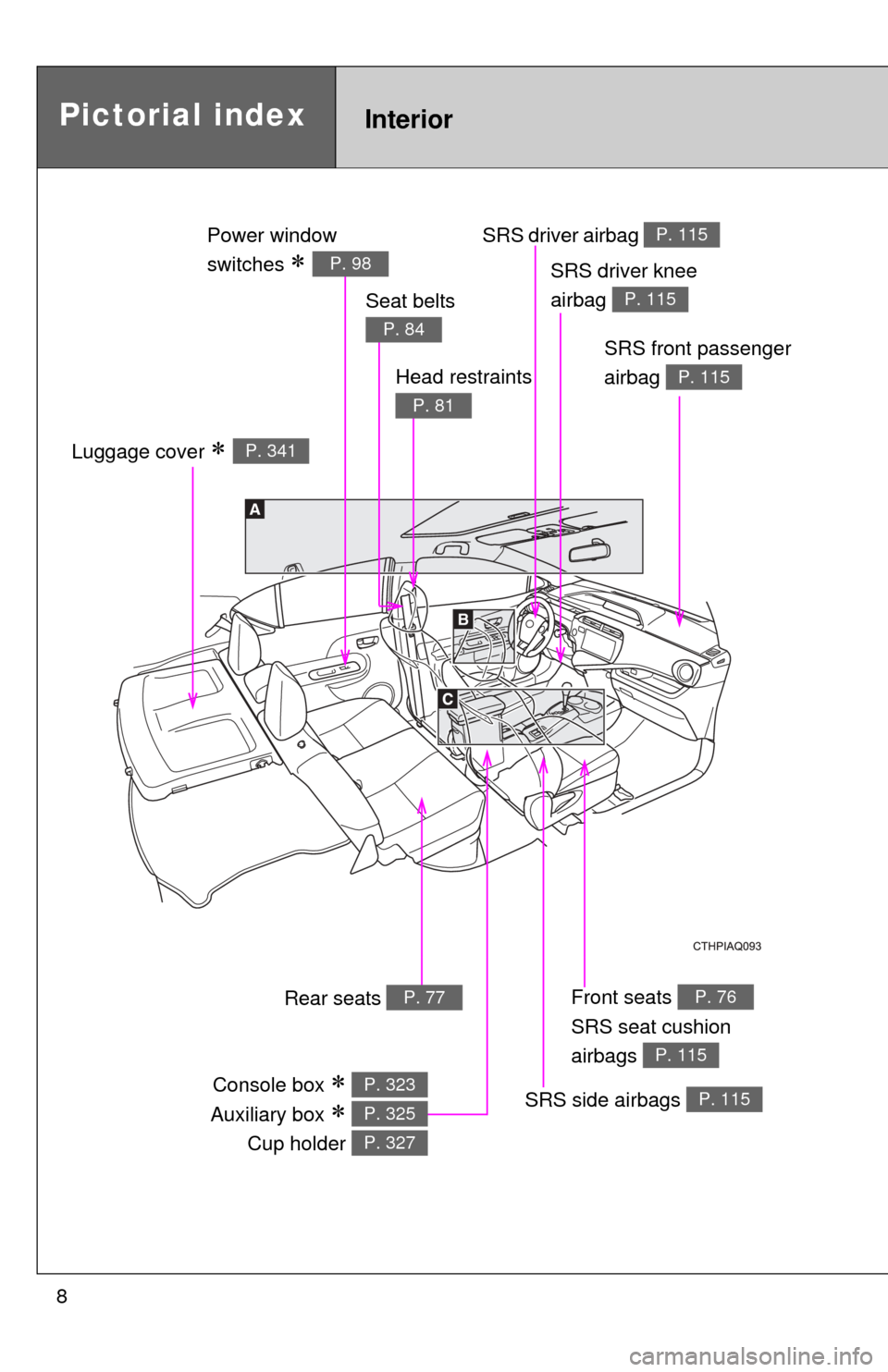
8
Pictorial indexInterior
SRS driver airbag P. 115
Front seats
SRS seat cushion
airbags P. 76
P. 115
SRS side airbags P. 115
SRS front passenger
airbag
P. 115
Luggage cover P. 341
Seat belts
P. 84
Head restraints
P. 81
Power window
switches
P. 98SRS driver knee
airbag
P. 115
Console box
Auxiliary box
Cup holder
P. 323
P. 325
P. 327
Rear seats P. 77
Page 9 of 556
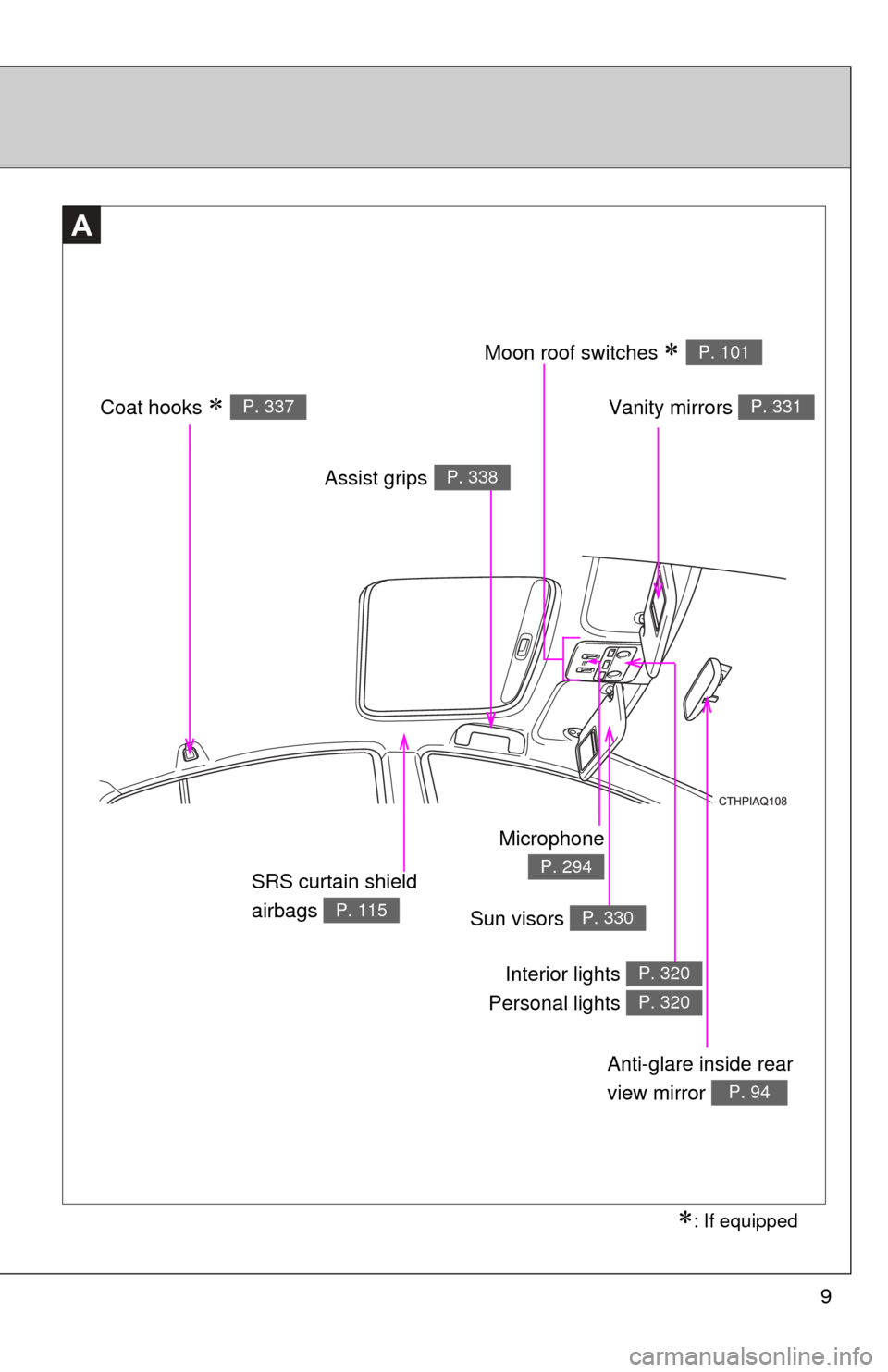
9
: If equipped
Anti-glare inside rear
view mirror
P. 94
Vanity mirrors P. 331
SRS curtain shield
airbags
P. 115
A
Moon roof switches P. 101
Sun visors P. 330
Interior lights
Personal lights P. 320
P. 320
Coat hooks P. 337
Microphone
P. 294
Assist gripsP. 338
Page 10 of 556
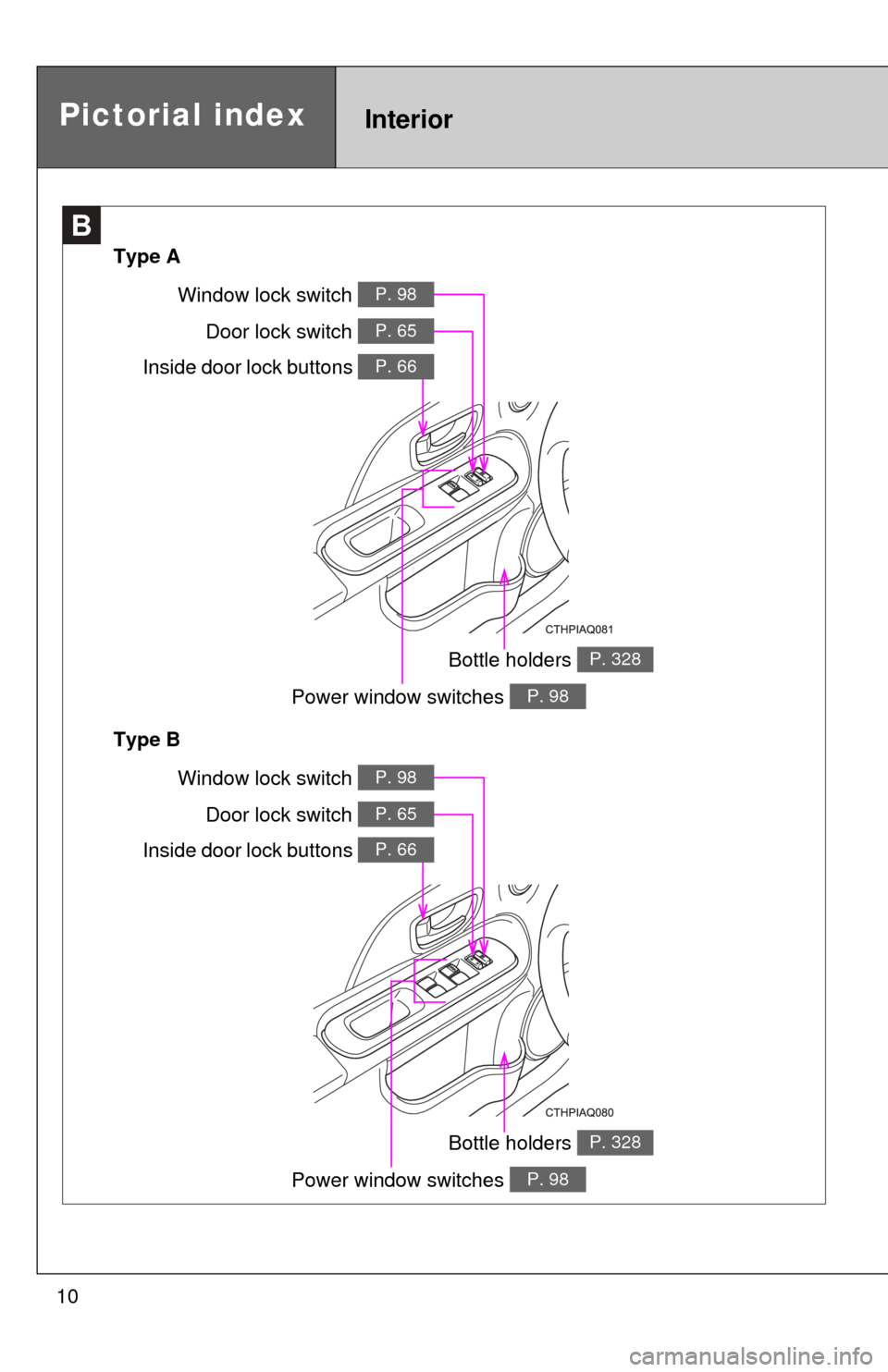
10
Pictorial indexInterior
B
Power window switches P. 98
Bottle holders P. 328
Door lock switch P. 65
Window lock switch P. 98
Type AInside door lock buttons
P. 66
Power window switches P. 98
Bottle holders P. 328
Door lock switch P. 65
Window lock switch P. 98
Type BInside door lock buttons
P. 66
Page 42 of 556
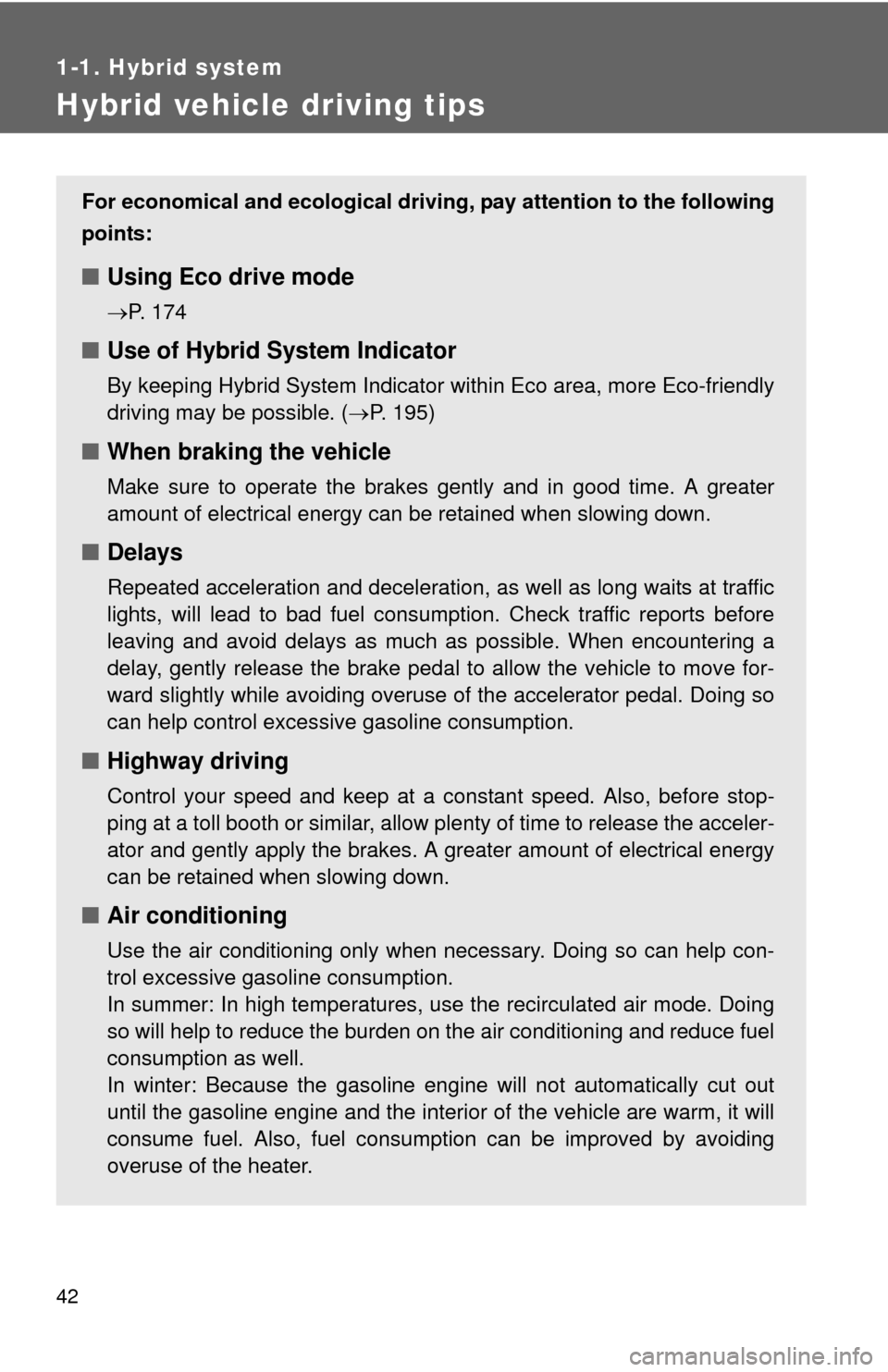
42
1-1. Hybrid system
Hybrid vehicle driving tips
For economical and ecological driving, pay attention to the following
points:
■ Using Eco drive mode
P. 174
■Use of Hybrid System Indicator
By keeping Hybrid System Indicator within Eco area, more Eco-friendly
driving may be possible. ( P. 195)
■When braking the vehicle
Make sure to operate the brakes gently and in good time. A greater
amount of electrical energy can be retained when slowing down.
■Delays
Repeated acceleration and deceleration, as well as long waits at traffic
lights, will lead to bad fuel consumption. Check traffic reports before
leaving and avoid delays as much as possible. When encountering a
delay, gently release the brake pedal to allow the vehicle to move for-
ward slightly while avoiding overuse of the accelerator pedal. Doing so
can help control excessive gasoline consumption.
■Highway driving
Control your speed and keep at a constant speed. Also, before stop-
ping at a toll booth or similar, allow plenty of time to release the acceler-
ator and gently apply the brakes. A greater amount of electrical energy
can be retained when slowing down.
■Air conditioning
Use the air conditioning only when necessary. Doing so can help con-
trol excessive gasoline consumption.
In summer: In high temperatures, use the recirculated air mode. Doing
so will help to reduce the burden on the air conditioning and reduce fuel
consumption as well.
In winter: Because the gasoline engine will not automatically cut out
until the gasoline engine and the interior of the vehicle are warm, it will
consume fuel. Also, fuel consumption can be improved by avoiding
overuse of the heater.
Page 52 of 556
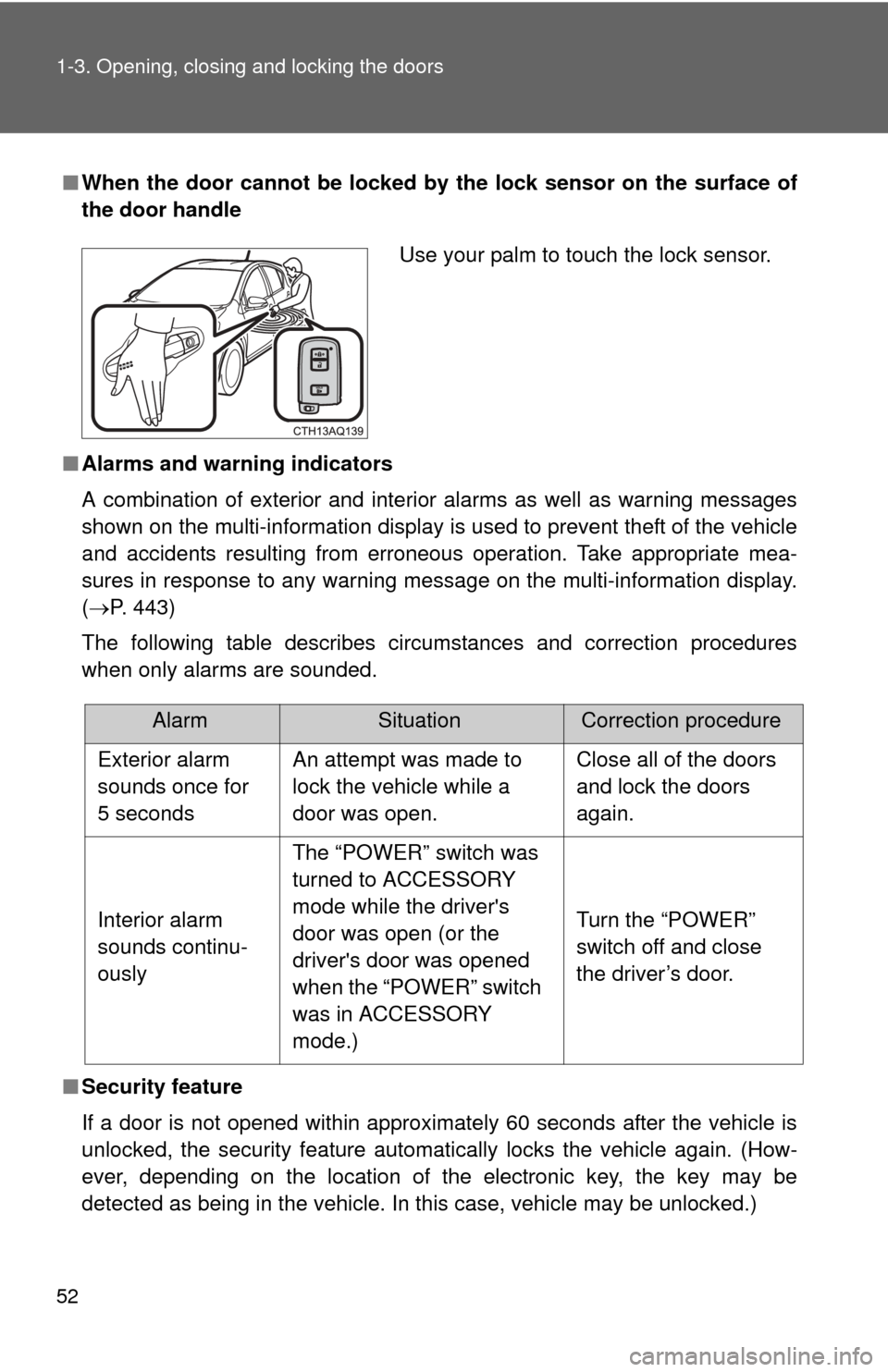
52 1-3. Opening, closing and locking the doors
■When the door can not be locked by the lock sensor on the surface of
the door handle
■ Alarms and warning indicators
A combination of exterior and interior alarms as well as warning messages
shown on the multi-information display is used to prevent theft of the vehicle
and accidents resulting from erroneous operation. Take appropriate mea-
sures in response to any warning message on the multi-information display.
(P. 443)
The following table describes circumstances and correction procedures
when only alarms are sounded.
■ Security feature
If a door is not opened within approximately 60 seconds after the vehicle is
unlocked, the security feature automatically locks the vehicle again. (How-
ever, depending on the location of the electronic key, the key may be
detected as being in the vehicle. In this case, vehicle may be unlocked.\
)
Use your palm to touch the lock sensor.
AlarmSituationCorrection procedure
Exterior alarm
sounds once for
5 seconds An attempt was made to
lock the vehicle while a
door was open. Close all of the doors
and lock the doors
again.
Interior alarm
sounds continu-
ously The “POWER” switch was
turned to ACCESSORY
mode while the driver's
door was open (or the
driver's door was opened
when the “POWER” switch
was in ACCESSORY
mode.) Turn the “POWER”
switch off and close
the driver’s door.
Page 53 of 556
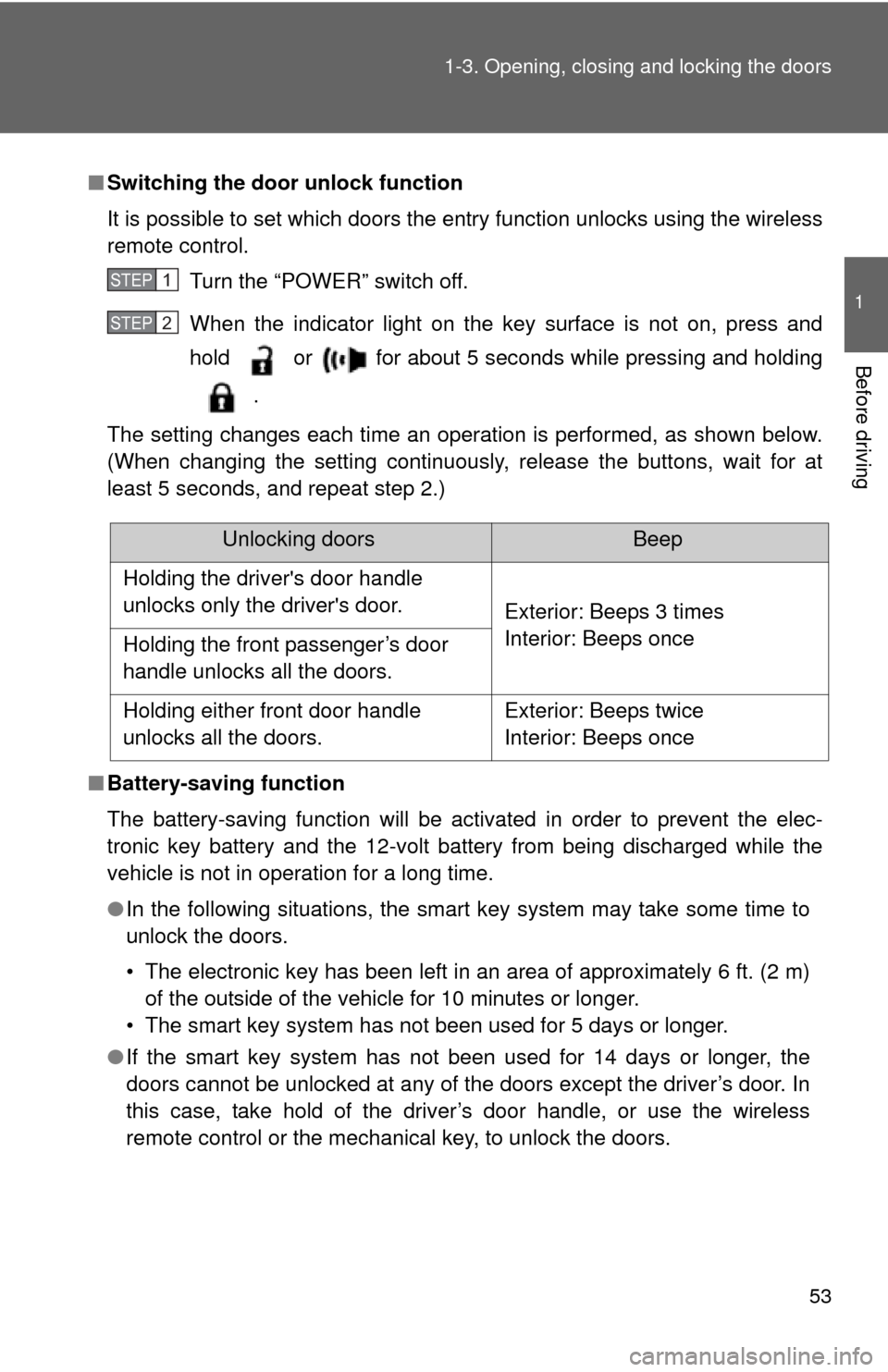
53
1-3. Opening, closing and locking the doors
1
Before driving
■
Switching the door unlock function
It is possible to set which doors the entry function unlocks using the wireless
remote control.
Turn the “POWER” switch off.
When the indicator light on the key surface is not on, press and
hold or for about 5 seconds while pressing and holding
.
The setting changes each time an operation is performed, as shown below.
(When changing the setting continuously, release the buttons, wait for at
least 5 seconds, and repeat step 2.)
■ Battery-saving function
The battery-saving function will be activated in order to prevent the elec-
tronic key battery and the 12-volt battery from being discharged while the
vehicle is not in operation for a long time.
●In the following situations, the smart key system may take some time to
unlock the doors.
• The electronic key has been left in an area of approximately 6 ft. (2 m)
of the outside of the vehicle for 10 minutes or longer.
• The smart key system has not been used for 5 days or longer.
● If the smart key system has not been used for 14 days or longer, the
doors cannot be unlocked at any of the doors except the driver’s door. In
this case, take hold of the driver’s door handle, or use the wireless
remote control or the mechanical key, to unlock the doors.
STEP1
STEP2
Unlocking doorsBeep
Holding the driver's door handle
unlocks only the driver's door. Exterior: Beeps 3 times
Interior: Beeps once
Holding the front passenger’s door
handle unlocks all the doors.
Holding either front door handle
unlocks all the doors. Exterior: Beeps twice
Interior: Beeps once
Page 92 of 556

92 1-4. Adjustable components (seats, mirrors, steering wheel)
CAUTION
■Using a seat belt extender
●Do not wear the seat belt extender if you can fasten the seat belt without
the extender.
● Do not use the seat belt extender when installing a child restraint system
because the belt will not securely hold the child restraint system, increas-
ing the risk of death or serious injury in the event of an accident.
● The personalized extender may not be safe on another vehicle, when
used by another person, or at a different seating position other than the
one originally intended.
NOTICE
■When using a seat belt extender
When releasing the seat belt, press on the buckle release button on the
extender, not on the seat belt.
This helps prevent damage to the vehicle interior and the extender itself.